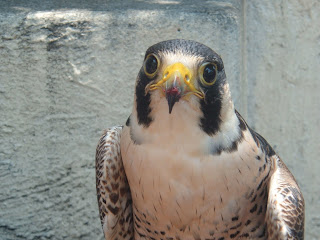
Well, here it is, the last one from the migration season 2008-2009. This cooper's hawk became an extended case for us due to a highly contagious protozoan infection which resulted in a lengthy stay in isolation in a small hospital cage. Due to the high strung personality of this type of hawk, she broke most of her flight feathers, rendering her unreleasable. It is a challenge to manage these types of cases because the longer they stay in captivity, the greater the odds that they will sustain even more injuries that may render them unreleasable. This extended stay in captivity that results in a release is an especially big reason to celebrate. Those that know and work with cooper's hawks can appreciate this on a deeply personal level. So while the reader
may shrug and say oh, another cooper's hawk release, we celebrate each victory as each one of these feisty warriors is truly a challenge and a beauty to behold!

The 2009-2010 migration finally brought us our first peregrine. He sustained a fracture to his left wing and has a really good prognosis. We will remove his bandage this weekend and allow him to move the wing a bit so as not to cause any stiffness or retraction of tendons. We are considering ourselves extremely fortunate as he is quite calm and we anticipate that we should see him out of our center sometime in November.
The weather has been quite hot this year averaging in the upper 80s to low 90s every day. Too hot for fall, and too hot I think for migrating birds. The turkey vultures have arrived but the rest are slow to come south, or maybe just avoided us altogether?




